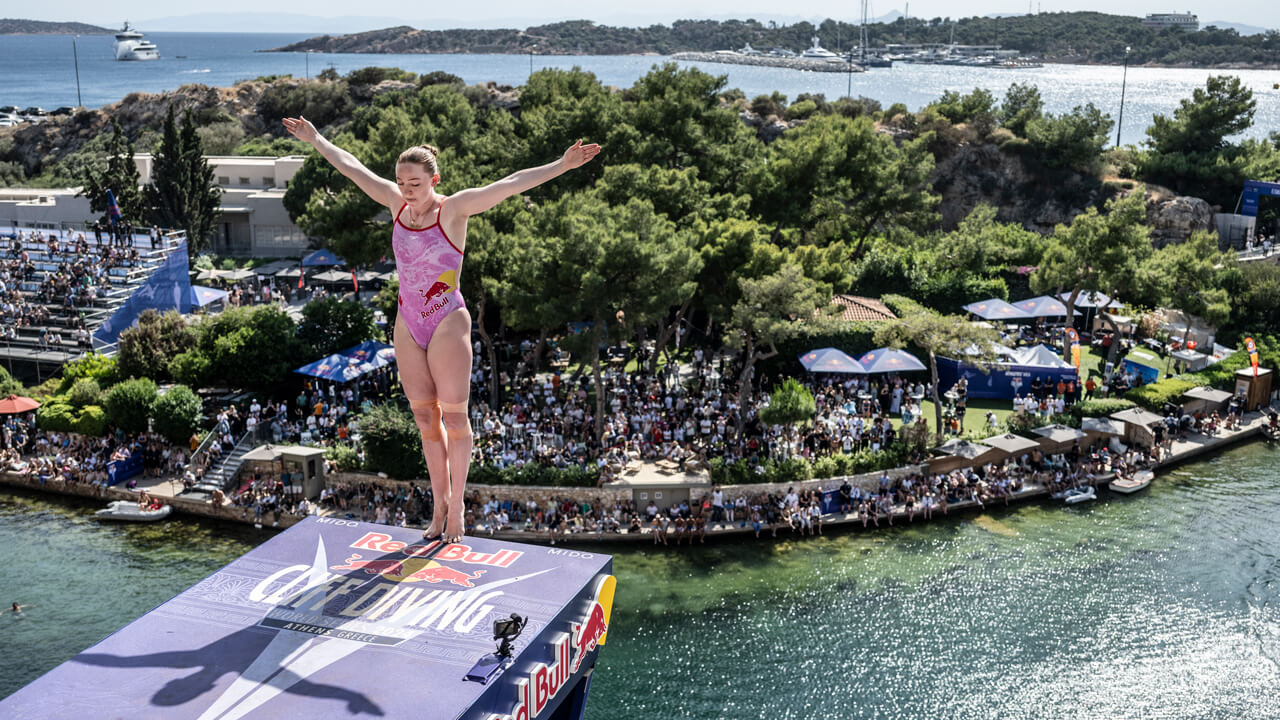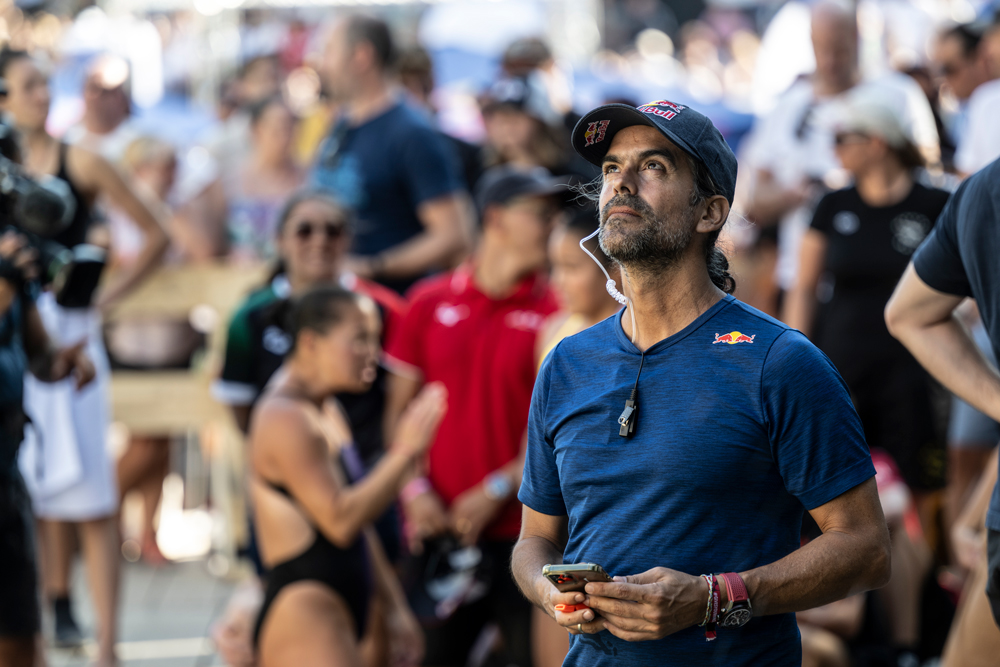Inside the precise, electric, brain-bending world of pro cliff diving
Orlando Duque was the first in history to pull off a triple somersault with one-and-a-half twists from 27 metres in the air before plunging into the water below. The Colombian won 13 cliff diving titles in all during his career, and he’s known as the sport’s pioneer.
Duque, 49, is now sports director for the Red Bull Cliff Diving World Series, which features competitions this season in cities located in eight different countries, including a stop in Montreal in August.
Sportsnet recently caught up with Duque to discuss everything from why it’s important to feel fear while competing and what it’s like to hit the water from those high heights, to who to watch on the circuit and how Canada’s Molly Carlson is helping push the limits of competition.
SPORTSNET: A video on the Red Bull website shows what it’s like to jump from various levels, starting from one metre, all the way up to 27. Some would call a three-metre drop terrifying. So, what does it take to compete in this sport?
DUQUE: Well, to compete at the level that we are, it takes a lot of skill, a lot of preparation. We’re talking 20 metres for the women, 27 metres for the men. It is a big dive; it is a big impact. So yes, you learn to control the body with the diving technique, but the impact is hard, so you have to be really strong to be able to handle it. You jump from three metres, that’s already a good height. From there, it just gets worse. The impact gets harder and harder and harder until you reach the level where we are.
What does it feel like to hit the water from 27 metres up?
We hit the water at about 85 kilometres an hour. And if you do a good dive, it feels okay. It’s actually a nice feeling — the sound, everything is nice. But if you make any small mistake, if you’re a little bit short on rotation or over on rotation, then the water is going to hit really hard and that’s going to hurt the next day. Of course, all the dives are not perfect, so after a weekend of diving, you can feel a little bit, you end up with a little bit of pain in your neck or your back. That’s why it’s so important that the athletes are strong and prepared to do those dives.
How do you overcome the fear to launch yourself from those heights?
You kind of have to convince yourself every time. Because naturally your body doesn’t want to do it. Your brain doesn’t want to let you do it because it could be dangerous. You have to convince yourself every time, like, ‘Hey, come on, I’m prepared. I trained enough for this. I’m strong enough to do what I’m about to do. I’m ready.’ You do have to convince yourself and reassure yourself. It’s not like you go out there and it’s automatic and you just jump. You really have to be very conscious, because if things go wrong then it could be costly. You don’t forget about that fear.
Is fear an important component of this sport?
Definitely. For me, after many years of experience, for sure. When you forget about that fear, when you lose the respect, let’s say, for the height, for what’s involved in a dive, then you can get complacent, and then you start forgetting little things. That’s when the small mistakes start to happen, and eventually it’s going to lead to an injury. I think it’s good to remember that. For me especially, it brought me back to focus, it brought me to where I needed to be to perform the dive safely.
For people who are new to the sport, what parts of the dive should they key in on?
Really there’s three main components on a dive. The takeoff: You want to see a good strong takeoff, a nice jump, you don’t want to see a scary push or a little push. The judges are looking for a nice push. And then the movements in the air. It has to be technically correct. It has to be done properly. The judges are very strict. You want to see those long lines, pointed toes. And finally, I think most people know this one: The water entry. No splash. There is a lot going on, but when you look at the big jump, and then you see all the stuff that’s happening, with a good entry, that’s going to be a good dive.
What are some of the most impressive things you’re seeing top competitors pull off these days?
In the last couple of years, we’ve seen the increase on the difficulty of the dives, like multiple twists and somersaults, adding more twists. This year, the hardest we’re going to be seeing is a back handstand, four-and-a-half somersaults in the pike position. A few years back that was, ‘Oh, that’s impossible.’ And there are two divers doing it now. It’s nice to see the progress of the sport. And again, as difficult as they are, these dives are being performed safely and repeatedly.
Who’s pulling off that move?
Catalin Preda from Romania and Nikita Fedotov — he’s Russian but competing as an independent athlete.
On the women’s side, how strong is that rivalry between Rhiannan Iffland and Canada’s Molly Carlson?
It’s really nice to see the competition that they put together in the last few years because it raised the sport to another level. Rhiannan and Molly, they have dominated the sport for the last couple of years — Rhiannan for a few more years than Molly, since Molly’s younger. But Molly has been there, stepping on her toes pretty much and winning already a few times. So she knows that feeling, she wants more of it. I know she’s working really hard. Rhiannan is knowing she has somebody so close, breathing on her neck. She’s also working really hard to maintain her dominance.
It’s a really good competition, and great to see that level of confidence when they stand on the platform — both of them, you look at their faces, you know they’re ready. They’re not playing around. There is no hesitation. The confidence they project, it’s unbelievable. I competed for a long time and when you look at them standing on the platform, you know it’s gonna be a really good dive.
Is theirs the fiercest rivalry in the sport right now?
On the men’s side, I think there’s five, even six people fighting for that top spot. In the last couple of years, we’ve had four, five, six winners. On the women’s side, we only have Rhiannan and Molly winning. Nobody else has won in the last few years. However, there are some people getting closer and I know they’ve been working really hard. There are some changes this year on degree of difficulty. There’s certain rules that are modified a little bit. We’ll see how that’s going to play out for the other divers that are getting closer.
Obviously, this sport draws mostly divers, but have you seen athletes change over from other sports to cliff diving?
Mostly for sure from diving because the technique the judges are looking at is from diving. But we have some gymnasts, we even have some trampolinists. But I would say that’s as far as we go. The technique is very strict, the judges are very strict, so they’re looking more toward diving. But let’s say gymnasts can adapt pretty easy to it, and then diving techniques. It’s really cool.
What are you most looking forward to about the event in Montreal?
In terms of the location, it’s really cool, right in the city. Every time we’re diving in the city it’s nice because it’s an open event, anyone can come and see it, it’s hopefully going to draw a lot of people. And of course, having a local diver in Molly there, it also adds to the excitement. Every time we have the chance to dive in our countries, it is a big plus. I had a chance to do a competition in Columbia and it feels really cool. The people are really into it, so we’re looking forward to that. And Canada also is going to be towards the end of the season, so by then you can already start seeing how the season is turning out. You can even see some title contenders already, so it becomes even more important by then to do a good event.
You’ve been involved in this sport a long time. What sort of growth have you seen since you started?
We never dreamed of what is happening right now in general with this sport, the technical aspect, the difficulty. Honestly, we never thought we were going to get this big. It’s been 15 years now. It’s crazy to see something that started so small and then now is this really full-blown World Series that is pushing the sport probably to the highest level in history.
Have you seen fan reception grow?
Yes, and I think it’s nice because I think people can relate to jumping into water. I think people can relate to the impact. When there’s people that follow it and for the people that just stumble upon it, they can really relate to it. And since we have some really cool locations, that is also very attractive. I think it has something for everyone. It’s not only for young, daring kids, it’s also for older adults. People really enjoy the component of the competition. It’s nice to see that we not only have following on media or on TV or on social media, but when we have the events on site, there’s people that come to watch and they know the name of the athlete, they know the rankings. They ask for pictures. That’s something that a few years back was not happening.
How often are you diving these days?
Not very often anymore, and I do not go to 27 metres. I think I did way too many of those [laughs]. But every now and then I go to the women’s platform and do one or two dives here and there.
Three somersaults, four twists?
[Laughs.] No, I take it very easy. I don’t have to complicate my life anymore, you know? I did it for too long. I just do a simple somersault. I’m having too much fun watching the competition and the younger divers.
Source link






